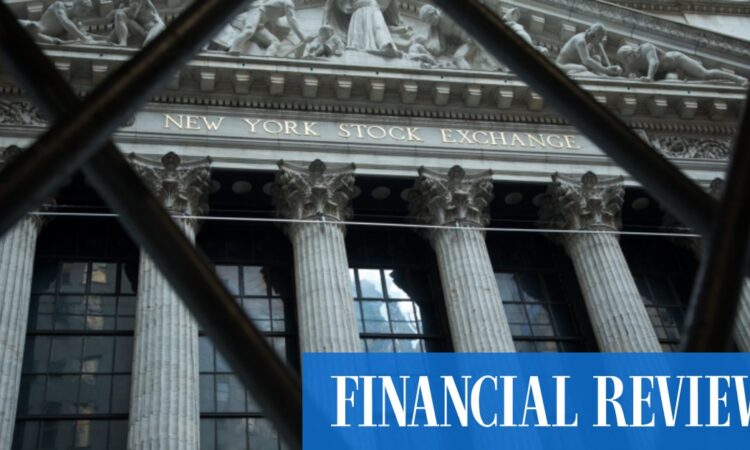
On Wall Street, utilities and real estate paced nine of the S&P 500’s industry sectors higher with consumer discretionary and financials lagging. The VIX fell 3.9 per cent to 21.74.
Today’s agenda
No local data
Overseas data: China February industrial profits; Eurozone March IFO business climate survey; US March Dallas Fed index
Other top stories
Unions ready NSW wage push: Within hours of Labor claiming victory over the Liberals, Unions NSW called the change an opportunity “to restart how we do industrial relations” in the state.
For the Liberals, this is worse than 2007: The situation facing the Liberal Party is more dire than November 2007, when every government, state and federal, was Labor.
ANZ boss says bank turmoil evokes savings and loan crisis: ANZ’s Shayne Elliott said there will be casualties, as the attention of financial markets turns to Deutsche Bank’s prospects to outrun the banking crisis.
Market highlights
ASX futures down 3 points or 0.04 per cent to 6980
- AUD -0.6% to 66.45 US cents
- On Wall St: Dow +0.4% S&P +0.6% Nasdaq +0.3%
- In New York: BHP +0.9% Rio +0.1% Atlassian -0.4%
- Tesla -0.9% Apple +0.8% Amazon -0.6% Block -1.9%
- In Europe: Stoxx 50 -1.8% FTSE -1.3% CAC -1.7% DAX -1.7%
- Spot gold -0.8% to $US1978.21/oz at 4.59pm in New York
- Brent crude -1.2% to $US74.99 a barrel
- Iron ore -0.3% to $US117.90 a tonne
- 10-year yield: US 3.38% Australia 3.21% Germany 2.12%
United States
Deposits at US lenders posted the biggest decline in nearly a year during the week when multiple bank failures triggered the latest bout of global financial turmoil.
The decline was entirely due to a record plunge in deposits at smaller institutions.
Bank deposits fell by $US98.4 billion to $US17.5 trillion in the week ended March 15, according to data released Friday by the Federal Reserve. Deposits at small banks slumped $US120 billion, while those for 25 largest firms rose almost $US67 billion.
**
Capital Economics’ Paul Ashworth asks whether small US banks and the commercial real estate sector will be “the next doom loop”.
In a note, Ashworth said in what would have echoes of the US savings and loan crisis, “maybe we should be more worried about deposit flight due to rising interest rates.
“Under those circumstances, the risk is that a pull-back in lending, particularly by small banks, triggers a downturn in commercial real estate which, in a worst-case scenario, could develop into an adverse feedback loop.”
Ashworth said commercial real estate, which accounts for 43 per cent of small bank loans outstanding, which is far higher than all other categories.
“While small bank lending in total is only 70 per cent of total lending by big banks, for commercial real estate specifically it is small banks that provide the lion’s share of funding. Small banks have $US1.9 trillion in commercial real estate loans outstanding, more than double the $900 billion extended by the big banks.
Wall Street reverses early losses to end higher, sentiment fragile All three US benchmarks closed modestly positive on Friday.
Tesla is losing a big force behind this year’s rally Retail traders whose purchases have helped push the electric-vehicle maker’s stock up over 50 per cent in 2023 are pulling back.
Price-to-earnings ratios a sobering stock price metric Headline US market gauges like the S&P 500 Index are roughly flat since reports of bank collapses surfaced two weeks ago.
Commodities
In a note, Fitch Solutions said it was maintaining its global average steel price forecasts for 2023 at $US825 a tonne, expecting prices to increase from current levels yet remain much lower than the highs seen during 2021-2022.
“Prices have averaged $US767 a tonne in the year-to-date as of March 22, we expect further upside in the coming months from current levels of $US770 a tonne.”
While Fitch said it expects mainland Chinese demand to pick up pace, “we do not expect demand and prices to head back to the highs seen during 2021-2022 as our macro team forecasts a slowdown in global growth from 3.1 per cent in 2022 to 2.1 per cent in 2023.
“Tight financial conditions and high inflationary pressures will remain key headwinds to growth in major developed markets. The ongoing conflict between Russia and Ukraine is not expected to abate anytime soon, further weighing on the EU’s overall economic outlook and placing a cap on steel prices.”





